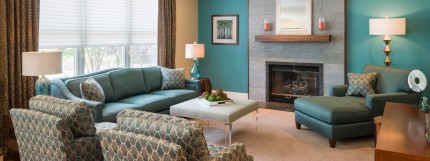Window treatments are a home accessory that many people don’t give much consideration to. They may seem like a decorative barrier between your home’s interior and the outside world, but the right window treatments can actually make your windows more energy efficient! Window accessories help to keep our homes cooler in summer and warmer in the winter, and they help you sleep better and provide aesthetic advantages. Discover some of the most energy efficient window treatments on the market:
Awnings. These window coverings add a Parisian touch to the exterior of your home and help to protect your doors and windows from elements like the scorching sun and pelting rain. Studies have shown that awnings can reduce solar heat gain in the summer months. Stylistically, awnings are offered in a variety of materials including metal, canvas, and synthetic fabric. Synthetic fabric awnings are a popular option because they are waterproof, mildew resistant, and require little maintenance.
Shades. Shades are the simplest and the most effective window treatments you can do to save energy. They should be installed as close to the window pane as possible for a sealed space.
- Roman Shades: This option is made of a single sheet of fabric that folds neatly as the curtains rise horizontally. Jackson, MI interior decorator Bonnie Lawitzke often recommends this option to her clients when redesigning bedrooms, as they offer protection against sunlight without sacrificing style and elegance.
- Cellular Shades: These shades feature honeycomb pockets which trap air and ultimately help to keep your home warmer in the winter and cooler in the summer.
- Woven Wood Shades: These are made of natural materials like wood, grass, bamboo and reeds and add an element of nature. They are effective in keeping rooms cooler and a stylish option for kitchens, basements, and entertaining areas.
Blinds. A classic window covering, blinds give you full control over the amount of natural light you let into a room. Interior blinds also help maintain the desired amount of ventilation and overall privacy. They are more effective during the summer months, as they prevent heat entry rather than heat loss during winters. Exterior blinds, on the other hand, work wonders stopping heat from getting to your windows by creating a barricade around your deck or porch. Unlike interior blinds which are made of fabrics, exterior blinds are most commonly made from vinyl, so they’re easy to maintain. In addition to energy saving, they also add elements of architectural aesthetics to the exterior.
Shutters. Louvered shutters offer flexibility in regulating the amount of light and heat entering the rooms. These adjustable, horizontal slats are angled to let light and air through, but in such a way that rain and direct sunshine are kept out. Shutters can be combined with other window settings for higher efficiency.
High-Reflectivity Window Film. This option is great for those who live in areas where winters are short. Essentially, they are sticker-like sheets that cling to your windows and reflect sunlight to keep your home cooler. They are capable of blocking 99% of UV rays and can even prevent furniture from fading. This window covering option lets in a moderate amount of light without compromising on your privacy, allowing you to depend less on artificial lighting during the day.
For the best in energy efficiency tips, check back to the Home Improvement Help Resource regularly!




